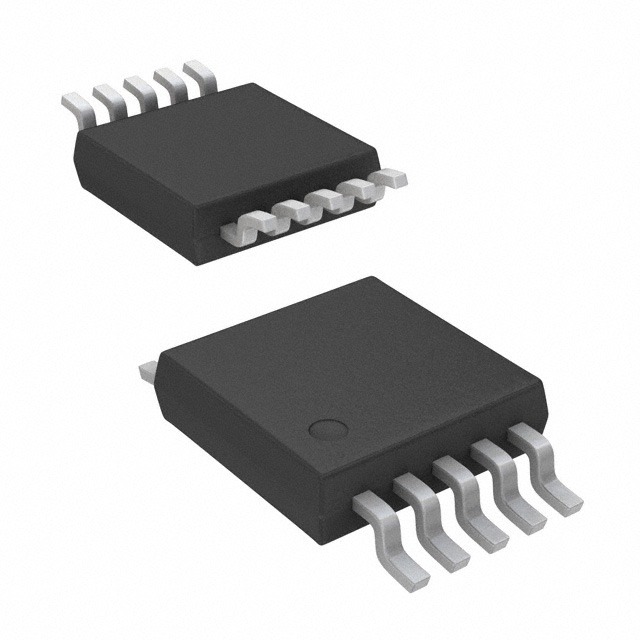AD5173BRM50
Product Overview
Category
AD5173BRM50 belongs to the category of digital potentiometers.
Use
It is used as a variable resistor in electronic circuits, providing a digitally controlled resistance value.
Characteristics
- Digital control: The AD5173BRM50 can be controlled digitally, allowing for precise adjustment of resistance.
- Non-volatile memory: It retains its resistance setting even when power is removed.
- Low power consumption: It operates with low power requirements.
- Wide resistance range: The AD5173BRM50 offers a wide range of resistance values.
Package
The AD5173BRM50 comes in a small outline integrated circuit (SOIC) package.
Essence
The essence of AD5173BRM50 lies in its ability to provide a digitally controlled variable resistance, offering flexibility and precision in electronic circuits.
Packaging/Quantity
The AD5173BRM50 is typically packaged in reels or tubes, with a quantity of 250 units per reel/tube.
Specifications
- Resistance range: 0Ω to 100kΩ
- Resolution: 256 steps
- Supply voltage: 2.7V to 5.5V
- Temperature range: -40°C to +125°C
- Interface: I2C-compatible
Detailed Pin Configuration
The AD5173BRM50 has the following pin configuration:
- VDD: Power supply voltage
- SDA: Serial data input/output for I2C communication
- SCL: Serial clock input for I2C communication
- GND: Ground connection
- A0: Address selection bit 0
- A1: Address selection bit 1
- WP: Write protect input
- RH: Terminal A of the potentiometer
- RW: Wiper terminal of the potentiometer
- RL: Terminal B of the potentiometer
Functional Features
- Digital control: The AD5173BRM50 can be controlled digitally using the I2C interface, allowing for precise adjustment of resistance.
- Non-volatile memory: It retains its resistance setting even when power is removed, ensuring consistent performance.
- Low power consumption: The AD5173BRM50 operates with low power requirements, making it suitable for battery-powered applications.
- Multiple devices on a bus: Several AD5173BRM50 devices can be connected to the same I2C bus, enabling control of multiple potentiometers.
Advantages and Disadvantages
Advantages
- Precise resistance control
- Non-volatile memory
- Low power consumption
- Wide resistance range
Disadvantages
- Limited resolution (256 steps)
- Requires I2C interface for control
Working Principles
The AD5173BRM50 is based on the principle of a digital potentiometer. It consists of a resistive element and a wiper terminal that moves along the resistive track, changing the effective resistance. The position of the wiper is controlled digitally through the I2C interface, allowing for precise adjustment of the resistance value.
Detailed Application Field Plans
The AD5173BRM50 finds applications in various fields, including:
- Audio equipment: It can be used for volume control in audio amplifiers and mixers.
- Instrumentation: It is suitable for calibration and fine-tuning of measurement instruments.
- Industrial automation: It can be utilized for control and adjustment of industrial processes.
- Automotive electronics: It finds application in automotive systems requiring variable resistance control.
Detailed and Complete Alternative Models
- AD8400ARZ10: Similar digital potentiometer with 10kΩ resistance range and 256 steps resolution.
- MCP4017T-503E/LT: Digital potentiometer with 50kΩ resistance range and 257 steps resolution.
- MAX5481EUD+: Digital potentiometer with 100kΩ resistance range and 256 steps resolution.
These alternative models offer similar functionality to the AD5173BRM50, providing options for different resistance ranges and resolutions.
In conclusion, the AD5173BRM50 is a digital potentiometer that offers precise resistance control, non-volatile memory, and low power consumption. It finds applications in various fields such as audio equipment, instrumentation, industrial automation, and automotive electronics. Alternative models with different specifications are also available in the market.
Lista 10 Vanliga frågor och svar relaterade till tillämpningen av AD5173BRM50 i tekniska lösningar
Sure! Here are 10 common questions and answers related to the application of AD5173BRM50 in technical solutions:
Q: What is the AD5173BRM50? A: The AD5173BRM50 is a digital potentiometer, which is an integrated circuit that can be used to digitally control resistance.
Q: What is the operating voltage range of the AD5173BRM50? A: The AD5173BRM50 operates within a voltage range of 2.7V to 5.5V.
Q: How many channels does the AD5173BRM50 have? A: The AD5173BRM50 has a single channel, meaning it can control the resistance of one circuit at a time.
Q: What is the resolution of the AD5173BRM50? A: The AD5173BRM50 has a resolution of 256 steps, allowing for precise control over the resistance value.
Q: Can the AD5173BRM50 be used in both analog and digital applications? A: Yes, the AD5173BRM50 can be used in both analog and digital applications, making it versatile for various technical solutions.
Q: What is the interface used to communicate with the AD5173BRM50? A: The AD5173BRM50 uses a standard I2C interface for communication with a microcontroller or other devices.
Q: Can the AD5173BRM50 be used in high-temperature environments? A: Yes, the AD5173BRM50 is designed to operate in temperatures ranging from -40°C to +125°C, making it suitable for high-temperature applications.
Q: Is the AD5173BRM50 capable of non-volatile memory storage? A: Yes, the AD5173BRM50 has integrated EEPROM memory that allows it to retain its settings even when power is removed.
Q: Can multiple AD5173BRM50 devices be daisy-chained together? A: Yes, multiple AD5173BRM50 devices can be connected in a daisy-chain configuration, allowing for control of multiple channels simultaneously.
Q: What are some typical applications of the AD5173BRM50? A: The AD5173BRM50 can be used in various applications such as audio volume control, programmable power supplies, calibration circuits, and sensor trimming.
Please note that these answers are general and may vary depending on specific use cases and requirements.


